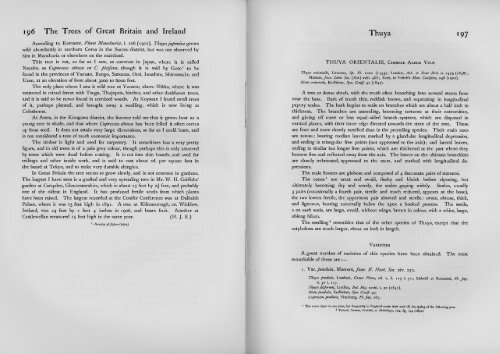the trees of great britain & ireland - Facsimile Books & other digitally ...
the trees of great britain & ireland - Facsimile Books & other digitally ...
the trees of great britain & ireland - Facsimile Books & other digitally ...
You also want an ePaper? Increase the reach of your titles
YUMPU automatically turns print PDFs into web optimized ePapers that Google loves.
196 The Trees <strong>of</strong> Great Britain and Ireland<br />
According to Komaror, Flora Manshuritz, i . 206 (1901), Thuya japonica grows<br />
wild abundantly in nor<strong>the</strong>rn Corea in <strong>the</strong> Samsu district, but was not observed by<br />
him in Manchuria or elsewhere on <strong>the</strong> mainland.<br />
This tree is not, so far as I saw, as common in Japan, where it is called<br />
Nezuko, as Cupressus obtusa or C. pisifera, though it is said by Goto 1 to be<br />
found in <strong>the</strong> provinces <strong>of</strong> Yamato, Bungo, Satsuma, Omi, Iwashiro, Shimotsuke, and<br />
Uzen, at an elevation <strong>of</strong> from about 3000 to 6000 feet.<br />
The only place where I saw it wild was at Yumoto, above Nikko, where it was<br />
scattered in mixed forest with Tsuga, Thujopsis, birches, and o<strong>the</strong>r deciduous <strong>trees</strong>,<br />
and it is said to be never found in unmixed woods. At Koyasan I found small <strong>trees</strong><br />
<strong>of</strong> it, perhaps planted, and brought away a seedling, which is now living at<br />
Colesborne.<br />
At Atera, in <strong>the</strong> Kisogawa district, <strong>the</strong> forester told me that it grows best as a<br />
young tree in shade, and that where Cupressus obtusa has been felled it <strong>of</strong>ten comes<br />
up from seed. It does not attain very large dimensions, so far as I could learn, and<br />
is not considered a tree <strong>of</strong> much economic importance.<br />
The timber is light and used for carpentry. It sometimes has a very pretty<br />
figure, and in old <strong>trees</strong> is <strong>of</strong> a pale grey colour, though perhaps this is only assumed<br />
by <strong>trees</strong> which were dead before cutting. It is cut into thin boards, and used for<br />
ceilings and o<strong>the</strong>r inside work, and is said to cost about 2 6.. per square foot in<br />
<strong>the</strong> board at Tokyo, and to make very durable shingles.<br />
In Great Britain <strong>the</strong> tree seems to grow slowly, and is not common in gardens.<br />
The largest I have seen is a grafted and very spreading tree in Mr. W. H. Griffiths'<br />
garden at Campden, Gloucestershire, which is about 25 feet by 2\ feet, and probably<br />
one <strong>of</strong> <strong>the</strong> oldest in England. It has produced fertile seeds from which plants<br />
have been raised. The largest recorded at <strong>the</strong> Conifer Conference was at Dalkeith<br />
Palace, where it was 15 feet high in 1891. A tree at Kilmacurragh, co. Wicklow,<br />
Ireland, was 24 feet by 2 feet 4 inches in 1906, and bears fruit. Ano<strong>the</strong>r at<br />
Castlewellan measured 25 feet high in <strong>the</strong> same year. (H. J. E.)<br />
1 Forestry <strong>of</strong> Japan ( 1904).<br />
Thuya 197<br />
THUYA ORIENTALIS, CHINESE ARBOR VITVE<br />
Thuya orientalis, Linnaeus, Sp. PL 1 002 (1753); London, Arb. et Frut. Brit. ^.2459(1838);<br />
Masters, Jour. Linn. Soc. (Hot.) xviii. 488; Kent, in Veitch's Man. Coniferce, 248 (1900).<br />
Biota orientalis, Endlicher, Syn. Conif. 4 7 (1847).<br />
A tree or dense shrub, with <strong>the</strong> trunk <strong>of</strong>ten branching into several stems from<br />
near <strong>the</strong> base. Bark <strong>of</strong> trunk thin, reddish brown, and separating in longitudinal<br />
papery scales. The bark begins to scale on branches which are about a half inch in<br />
thickness. The branches are ascending, becoming tortuose at <strong>the</strong>ir extremities,<br />
and giving <strong>of</strong>f more or less equal-sided branch-systems, which are disposed in<br />
vertical planes, with <strong>the</strong>ir inner edge directed towards <strong>the</strong> stem <strong>of</strong> <strong>the</strong> tree. These<br />
are finer and more closely ramified than in <strong>the</strong> preceding species. Their main axes<br />
are terete; bearing median leaves, marked by a glandular longitudinal depression,<br />
and ending in triangular free points (not appressed to <strong>the</strong> axis); and lateral leaves,<br />
ending in similar but longer free points, which are thickened at <strong>the</strong> part where <strong>the</strong>y<br />
become free and reflected away from <strong>the</strong> axis. The leaves on <strong>the</strong> ultimate branchlets<br />
are closely imbricated, appressed to <strong>the</strong> stem, and marked with longitudinal de<br />
pressions.<br />
The male flowers are globose and composed <strong>of</strong> 4 decussate pairs <strong>of</strong> stamens.<br />
The cones 1 are erect and ovoid, fleshy and bluish before ripening, but<br />
ultimately becoming dry and woody, <strong>the</strong> scales gaping widely. Scales, usually<br />
3 pairs (occasionally a fourth pair, sterile and much reduced, appears at <strong>the</strong> base),<br />
<strong>the</strong> two lowest fertile, <strong>the</strong> uppermost pair aborted and sterile: ovate, obtuse, thick,<br />
and ligneous, bearing externally below <strong>the</strong> apex a hooked process. The seeds,<br />
2 on each scale, are large, ovoid, without wings, brown in colour, with a white, large,<br />
oblong hilum.<br />
The seedling 2 resembles that <strong>of</strong> <strong>the</strong> o<strong>the</strong>r species <strong>of</strong> Thuya, except that <strong>the</strong><br />
cotyledons are much larger, about an inch in length.<br />
VARIETIES<br />
A <strong>great</strong> number <strong>of</strong> varieties <strong>of</strong> this species have been obtained. The most<br />
remarkable <strong>of</strong> <strong>the</strong>se are :<br />
i. Var. pendula, Masters, Jour. R. Hort. Soc. xiv. 252.<br />
Thuya pendula, Lambert, Genus Pinus, ed. 2, ii. 115 t. 5 2; Siebold et Zuccarini, Fl. Jap.<br />
ii. 30 t. 117.<br />
Thuya filiformis, Lindley, Bot. Reg. xxviii. t. 20 (1842).<br />
Biota pendula, Endlicher, Syn. Conif. 49.<br />
Cupressus pendula, Thunberg, Fl. Jap. 2 65.<br />
1 The cones ripen in one year, but frequently in England retain <strong>the</strong>ir seed till <strong>the</strong> spring <strong>of</strong> <strong>the</strong> following year.<br />
1 Tubcuf, Samcn, Friichtc, u. Kcimliiige, 104, fig. 144 (1891).













